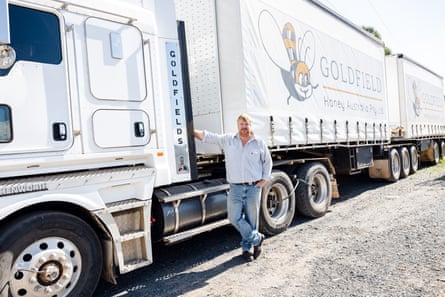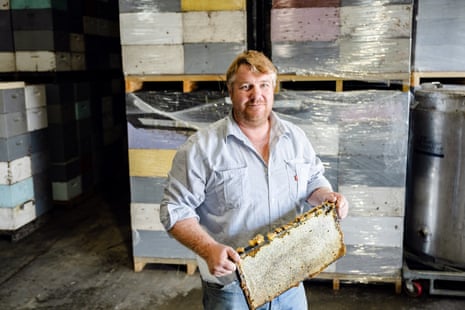In September Jon Lockwood travelled to an almond orchard in Balranald in the New South Wales Riverina, and euthanised about 2,500 of his bees.
The honeybees were in a varroa “red zone”, an area deemed at high risk of infestation of the parasitic varroa mite (Varroa destructor), which prompted the destruction of bees in commercial hives since it was first detected in sentinel hives in June 2022.
“The orchard needed to get on with their daily duties and they couldn’t with the bees being quarantined, so we headed over to euthanise them ourselves,” Lockwood says. It amounted to 20% of the bees operated by Lockwood’s business, Goldfields Honey.
Two weeks later, authorities abandoned efforts to eradicate the pest.
The varroa mite has become a lead character in the debate about how to strengthen biosecurity in Australia. From 1 July, primary producers like Lockwood will be subject to a new biosecurity protection levy, which aims to spread the cost of supporting the biosecurity system across those who need it most.
But with low honey prices and the ongoing costs of managing the varroa mite, Lockwood says the added cost of the levy could be too much to bear.
“We’ve got to find a lot of money to treat the varroa mite and additional labour to implement the treatments. Now we have to find more money to pay for biosecurity,” he says. “I don’t think that we should pay for it – agriculture as a whole is suffering. I don’t think that we can afford to pay for it.”
Lockwood says it would cost about $50 a hive to treat a varroa incursion. The operation runs about 10,000 hives, each churning out about 100kg of honey a year. The biosecurity levy could add a further 0.0046c a kilogram of honey produced.
‘Whacked with an extra $50m’
Under the proposal announced in the federal budget last year, primary producers will cover about 6% of the biosecurity protection levy. Importers, considered to bring the highest risk, will pay about 48%, with taxpayers and Australia Post covering 44% and 2%, respectively.
The National Farmers Federation opposes the levy, saying farmers already bear the cost of biosecurity.
“Farmers recognise they have a role to protect the biosecurity system, but I would say that the producers are already paying that system,” the NFF’s chief executive, Tony Mahar, told a parliamentary hearing into the levy on Tuesday. “We warmly welcomed the contribution commitment from the Albanese government around a locked-in source of funding … what we didn’t ask for was to get whacked with an extra $50m that we don’t know where it’s going to be spent.”
The principal policy analyst at the Invasive Species Council, Dr Carol Booth, says the risk of pest or disease outbreaks was increasing due to the increased volume of trade and the climate crisis, but the resourcing of the biosecurity system has not kept pace.

“Those who are really embedded in biosecurity … are really well aware of that,” she says. “They know that a lot of the improvement you can make for the environment will have benefits for agriculture as well.”
The Australian Veterinary Association says the costs of biosecurity “should be shared with the whole community,” rather than leaving individuals on the frontlines to pick up the costs.
“Veterinarians are key players in a strong biosecurity system that can detect animal disease threats early,” a spokesperson says. “They need to be on farms to undertake passive biosecurity surveillance and work with primary producers to optimise farm planning and practices. The cost of doing this is currently met by the veterinary profession and farmers, and it’s not sustainable.”
All stakeholders agree that better communication and education around biosecurity risks should be part of the picture.
after newsletter promotion
David Refalo, a pig farmer, says he hadn’t heard of the levy before speaking to Guardian Australia. He managed an outbreak of Japanese encephalitis in his free-range herd near Cowra in central western NSW in 2022, after flooding led to an increase in mosquito numbers.
“You’re not going to stop mozzies from getting in contact with your pigs unless you put them in a totally enclosed shed, which isn’t possible,” he says.
Refalo’s sows recovered, but remain at risk from the spread of brucellosis from feral pigs and dogs. The proposed levy would cost him just over $0.18 a pig sent to the abattoir, according to figures provided by the federal department of agriculture. Refalo says he’d like to see a greater focus on controlling the feral pig population and existing biosecurity threats.
Brucellosis is one of over 100 nationally notifiable diseases and can cause pregnant sows to lose their young. The Greens’ spokesperson for agriculture, Peter Whish-Wilson, says the proposed biosecurity levy should be interrogated to ensure “communities, the environment and industry are safeguarded in the future”.
“The direction of collected levy funds into consolidated revenue is a key concern with the bill in its current form,” he says. “The current structure and application of this legislation needs work.”
There are 32 active biosecurity incidents being managed in Australia, including incursions of the red imported fire ant (Solenopsis invicta), polyphagous shot-hole borer (Euwallacea fornicatus) and varroa mite (Varroa destructor).
A spokesperson for the department of agriculture says the proposed levy would be the first time Australia has had “consistent, locked-in, ongoing funding to underpin our strong biosecurity system at the border”.
“Investing in a strong biosecurity system at the border is much cheaper than paying for the cleanup of an outbreak and the far-reaching impacts on the cost of living,” they said.
This article was amended on 26 April 2024 to replace part of a quote from Peter Whish-Wilson that was published inadvertently.

Comments (…)
Sign in or create your Guardian account to join the discussion